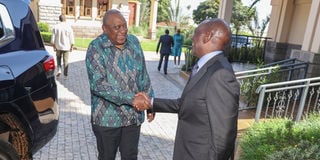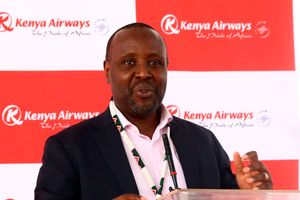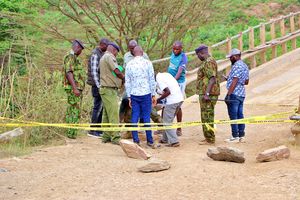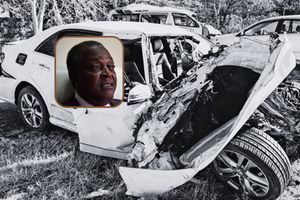Premium
Why Ruto visit to Uhuru is all about 2027 arithmetic

President William Ruto pays a courtesy call to former President Uhuru Kenyatta at his Gatundu home on December 9, 2024.
In African culture, a visit by an elder to another elder’s homestead often carries more significance than is visible to the plain eye.
President William Ruto’s early December courtesy call on his predecessor, Uhuru Kenyatta, at the latter’s Ichaweri home in Gatundu, Kiambu County, was officially billed as normal consultation between statesmen for purposes of sharing ideas on national matters, political reconciliation, economic challenges and governance. After the high-profile meeting, the two leaders issued two separate statements.
President Ruto’s statement emphasised the achievements of the Kenya Kwanza administration and praised Kenyatta’s legacy as a statesman. The President singled out the fact that the former head of state handed over power peacefully to the winning candidate despite supporting a different candidate. The head of state attributed the current economic woes facing Kenya to global factors such as the Covid-19 pandemic and the Russia/Ukraine war that have disrupted global supply chains.
On his part, Mr Kenyatta urged the current administration to bridge the widening political divide, stop harassment of opposition figures, establish a strong and effective opposition, reconstitute the Independent Electoral and Boundaries Commission (IEBC), and embrace inclusivity in governance.
On the surface, the issues raised by the two statesmen were critical to addressing political tension and economic challenges that the country is currently grappling with.
Drawing board
Pundits, however, opine that the visit was part of President Ruto’s strategy to pacify and regain influence over the Mount Kenya region that has been drifting away following the impeachment of former Deputy President, Rigathi Gachagua. It is apparent that the region had their eye on Gachagua as part of their succession plan, and his removal from the number two slot has caused shockwaves and sent them back to the drawing board. The appointment of Kithure Kindiki from the numerically inferior Tharaka Nithi in place of Gachagua has only reaffirmed the Gikuyu as the fulcrum of Gikuyu Embu and Meru Association (GEMA). The President’s new Deputy President is yet to have any meaningful political impact in the region.
It is very unlikely that the populous Gikuyu will consider Kithure Kindiki as a suitable replacement for their man, Gachagua. Critics argue that the main role that the Embu and Meru have played since the formation of GEMA has been to act as ‘flower girls’ for their Gikuyu cousins in political duels with ‘outsiders.’
Therefore, if the government thought that Kindiki’s appointment had the potential to consolidate the entire Mount Kenya region to support the President, then the strategy has fallen flat on its face. The region remains largely unmoved by this appointment, and it should not be surprising if it pools its votes into one basket against President Ruto. In the August 2022 presidential poll, the vote-rich Mount Kenya region threw its weight firmly behind President Ruto.
Ruto won the presidency even though his main rival at the time, Raila, was believed to enjoy tremendous state goodwill. It has been argued that President Ruto’s slight win over Raila was attributed to the massive support that he got from the Mount Kenya region. So intense was the region’s support for Ruto that the voters curiously defied President Kenyatta’s counsel to support Raila. With time has become clear that the region’s decision on the 2022 presidential poll was more about the disdain of Raila than the love of Ruto. In a nutshell, President Ruto won the Mount Kenya region’s votes not because they loved him, but because they hated Raila with passion. The vote was, above everything else, to stop Raila from ascending to the presidency.
The significance of the foregoing is that if Raila becomes the next Chairman of the African Union Commission in February 2025, and chooses not to contest the presidency in 2027, the Mount Kenya region will be walking on political eggshells. First, the voter turnout in the region might be significantly reduced. This is because the “scarecrow” that has previously been used to mobilise voters ostensibly to protect their region from perceived dangers will not be on the presidential ballot.
At the same time, the Mount Kenya region would prefer a situation where Raila is on the presidential ballot in 2027 to deny Ruto a formidable voting bloc comprising former Nyanza, Coast, Western and Rift Valley provinces. Such a situation would make both Raila and Ruto highly susceptible to defeat by a candidate sponsored by the Mount Kenya region, which is likely to vote as a bloc. In addition, there is the Kalonzo Musyoka factor.
Presidential bids
The former Vice President has stood by Raila at least three times in his successive presidential bids. It is now Raila’s turn to support Kalonzo to try his luck at the presidency. If this comes to pass, then President Ruto’s re-election in 2027 would be in great jeopardy. Both Ruto and the Mount Kenya leaders are alive to this fact, hence the unrelenting focus on Raila as the 2027 ‘King Maker.’
Since Raila announced his support for a broad-based consultative framework to address some of the woes that the country was facing, the Mount Kenya axis has interpreted this move as the clearest sign yet that Raila is drifting towards President Ruto, and might, in fact, jolt his chances in 2027. The region has responded to Raila’s move by trying to blackmail him as a sellout who rushed to support Ruto to stay in power when the country’s youths wanted him out. Keen observers have discerned a determination by the Mount Kenya region to blame all the country’s woes since 2013 on President Ruto.
In fact, a narrative is being bandied around that all the mega corruption cases during Uhuru’s reign that have been reported by the Auditor General were all perpetrated by William Ruto while the president was busy on national issues. Amidst all the Raila and Ruto bashing, the Mount Kenya team appears to have forgotten that it was them, and not Raila, who made Ruto president. One wonders why people would make a deliberate decision, then expect Raila to come to their rescue once they have burnt their fingers. Matters were not made any better when Raila’s party, ODM, released five of its senior members to join Ruto’s Cabinet.
There have been intensified calls to have ODM members leave the Cabinet. Curiously, the same people who are asking Raila to stop supporting Ruto’s government have not asked Cabinet Secretaries and Principal Secretaries from their regions or political parties to resign from the same government that they seem to hate so much! If the Mount Kenya axis truly believes that Ruto’s government is irredeemably bad, then they should surely ask everybody in the government to resign, and not just former ODM officials. That smacks of dishonesty.
The same Mount Kenya team has been decampaigning Raila for the AUC Chairmanship. This is a huge deviation from best practice where countries show unqualified support to their own citizens when gunning for regional or international positions.
Sadly, some Kenyans are wishing Raila bad luck so that he not only remains in the country, but also contests the presidency in 2027. The group is determined to create a wedge between President Ruto and the ODM leader, in a bid to have both of them in the presidential ballot to divide their formidable voting bloc. On the other hand, President Ruto, being cognizant of the fact that he may have lost a big chunk of his erstwhile support base in the Mount Kenya region, is desperate to keep Raila in his corner, and hopefully become a beneficiary of a “Ruto Tosha” moment in 2027. Perhaps more than any other politician in Kenya today, Raila enjoys a frenzied following in many parts of Kenya. As he moves into his political sunset -the veteran politician turns 80 next month - it should be in his objective interest to hand over the dyed-in-the-wool support bases to a capable politician under whose wings a new leader can emerge. President Moi nurtured the Gikuyu community for more than two decades after Jomo Kenyatta’s demise. Likewise, Raila played such a role to the Kalenjin community after President Moi went into retirement until Ruto emerged to lead them.
Exits political stage
As fate would have it, if Raila exits the local political stage, President Ruto is poised to play a foster father role for the Luo community until another strong leader emerges organically to succeed Baba. Another constituency that President Ruto needs to pay meticulous attention to is the Gen-Z brigade. Following the June uprisings, the government is yet to win back the Gen-Zs into their fold. Given their huge numbers, the Gen-Zs can easily sway the vote in 2027. The government can only take the Gen-Zs for granted at their own risk. The winner of the 2027 presidential poll is likely to be the political formation that will fully embrace the Gen-Zs, and incorporate them into key decision-making organs within their ranks.
Meanwhile, Kenyatta remains the undisputed Gikuyu leader, whose wise counsel is greatly sought after by the community. A visit by President Ruto to Ichaweri signalled a thawing of relations with his predecessor. After all, the old adage says that there is no permanent enmity in politics, only permanent interests. Nothing stops Uhuru and Ruto from working together in 2027. The two politicians have been tied at the hip since their days in Kanu.
Uhuru seems keen on consolidating his legacy, which appeared to have been thrown into disarray when the Mount Kenya voters rejected his choice for the presidency in 2022. It is highly likely that President Ruto’s forays into the Mount Kenya region will not stop any time soon.
The President needs to intensify his visits to the region with the hope of reducing the sympathy votes that Gachagua now enjoys in abundance. In a Presidential system, where a winning candidate requires only one vote above his/her closest competitor, the president cannot afford to ignore any vote. In the absence of Gachagua, the only other person who can help President Ruto to mobilise votes in the Mount Kenya region is Uhuru Kenyatta. The visits shall continue, and the country shall continue to watch them closely.
Professor Ongore teaches at the Technical University of Kenya





